
How to Write a Compare and Contrast Essay, Step by Step

So, you’re here to learn how to write a compare and contrast essay.
Great! This post is the ultimate guide to help you understand the purpose of this writing, the process of discovering similarities and differences to outline there, and the structure of compare/contrast essays to keep for crafting A-worthy works.
Actionable tips and examples are also here, so let the game begin!
Table of Contents:
What is a Compare and Contrast Essay?
What does compare and contrast mean?
- Compare definition: The process of showing the similarities between two subjects or ideas.
- Contrast definition: The process of showing the differences between two subjects or ideas.
The skill of comparing and contrasting is critical in academic writing because it allows you to build arguments, the core part of essays.
While it may seem challenging to write about two subjects in one essay, it’s not so. The main thing is to decide on a topic and choose two objects for comparing and contrasting.
The Purpose of Compare/Contrast in Writing
When writing a compare and contrast essay, you (the author) want readers to understand the subject better. So, you take another subject for them to use as a frame of reference:
When we see two relative concepts next to each other and read explanations of their similarities and differences, it’s easier for us to understand both.
But:
The purpose here is not to state the obvious but showcase elements of a similar category to illuminate their unexpected similarities or subtle differences. Your goal is to increase the reader’s understanding of that category.
Unlike persuasive or informative essays, compare and contrast writing deals with two or more topics instead of focusing on one. You don’t describe a single subject but grasp several related concepts to prove your thesis by comparing and contrasting them.
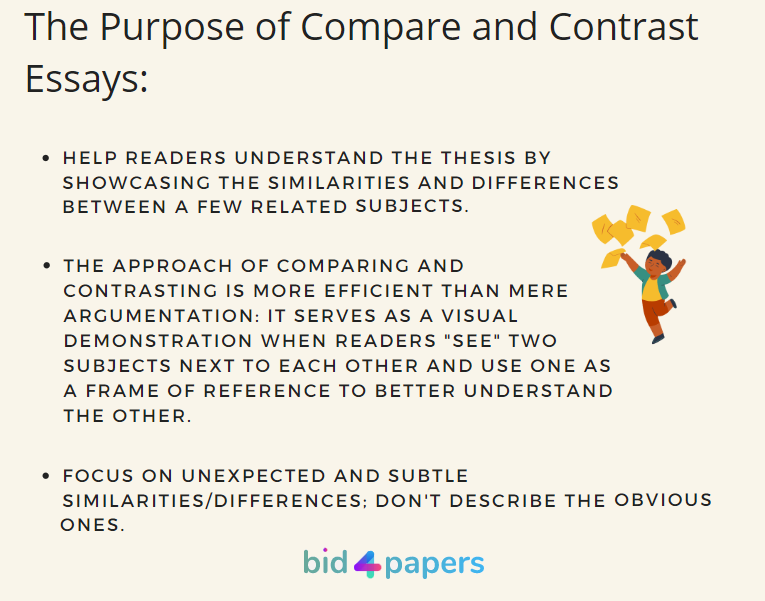
How do I know if I need to compare and contrast something in my essay?
Two cases:
- First, the assignment itself may invite you to compare something.
For example, you get a prompt like, “Compare the treatment of fear in the prose of Bram Stoker and H.P. Lovecraft” or “Compare and contrast offline and online learning. What are the pros and cons of each option?”
- Second, the assignment may not directly ask you to compare or contrast something, but it may sound like a compare-and-contrast approach could work best to deal with the task.
For example, it says something like, “Discuss the effects of the 2010 eruption of Eyjafjallajokull in Iceland.” So, here you might want to contrast the situation before this volcano eruption with the one during it: It would help highlight the differences and effects better.
It’s worth noting that the compare-contrast approach works for different types of academic papers: When writing a book critique or review, you may want to compare various research on it; when dealing with dialectic essays, you’ll weigh up the pros and cons of different arguments, etc.
How to Write a Compare and Contrast Essay: 7 Steps
And now, to practice:
Below are the seven steps to follow when writing a compare and contrast essay. The most challenging part is stating a thesis and deciding on a structure, but no worries: We’ve got you covered!
Here go the steps:
Step 1: Choose a Subject
Compare and contrast essay topics can be about everything: literature, historical events and personas, sociology, psychology, etc. As a rule, it’s a teacher assigning the subject, so you won’t have to think over yours and worry if it’s good enough to cover.
But if no particular topic is there and you need to choose it by yourself, here’s the only rule to follow:
Two or more subjects you’ll describe in an essay should be different yet relate to the same category. In other words, you’d better compare and contrast two musicians than a musician and a politician. Or, it’s better to compare/contrast e-books and textbooks than e-books and movies.
Below is the list of compare and contrast essay topics you can refer to when necessary:
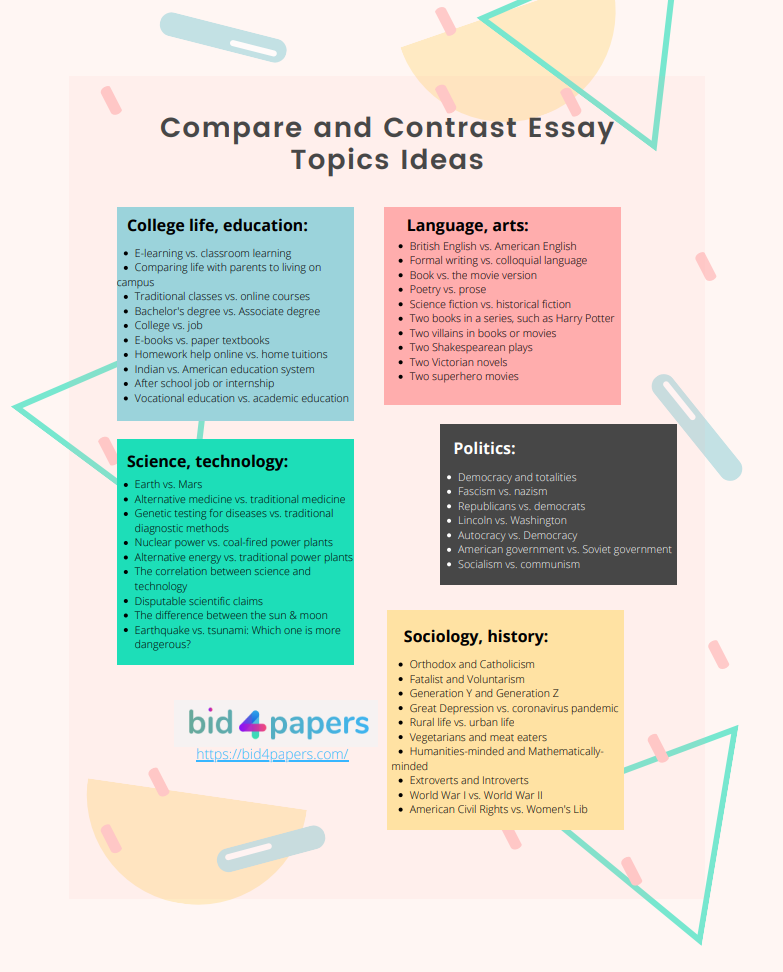
Step 2: Discover Similarities and Differences
Now when you have a topic and subjects to compare, it’s time to discover the similarities and differences you’ll focus on in your essay.
The most common way to do that is to create two lists: one — for similarities and another one — for differences. But while it works great when specifying similarities, a list of differences might become confusing because you’ll need to expand it further to specify what difference relates to each of compared subjects.
The more comfortable way is to create a table:
List the criteria you want to focus on in your essay, and then complete the table for every subject you’re going to compare/contrast. Let’s try this method with something most of us love: pizza! (Inspired by WritingCenter)
| Pepper’s | Amante | |
| Location | ||
| Price | ||
| Delivery | ||
| Ingredients | ||
| Service | ||
| Seating in | ||
| Coupons |
Another way to quickly compare and contrast two things is through a Venn diagram. Draw overlapping circles with a joint area in the center: This area will be for specifying the similarities, and those not overlapping will describe differences. Like this:

Tables, diagrams, charts — all they work when it comes to data visualization in essays, especially in the research stage. You are free to use anything that helps you determine the ideas and references for your work.
Step 3: Write a Thesis
Please remember that your compare and contrast essay is not about enumerating similar and different points about two subjects. Remember the purpose? You use the approach of comparing and contrasting, focusing on subtle criteria, for readers to better understand your thesis.
You need to go beyond listing and state a meaningful thesis:
- What do you want to say with this comparison? What’s the ground for it?
- Why did you choose these particular objects to contrast? How do they relate to one another?
- What’s your point?
Here is how to write a thesis for a compare and contrast essay:
Look at the lists of the similarities and differences you’ve made and try to specify the most significant ones. What do they say about the topic? Do they extend, correct, contradict, or debate one another? The answer to this question, specifying the relationship between your two chosen objects, will be your main argument, aka thesis. It should do two things:
- Address the comparison
- Contain the categories on which you’ll hang facts to make it
Let’s make it clearer with the example.
Subject: Judaism vs. Christianity Thesis: While both Judaism and Christianity are Abrahamic religions sprung from the same cultural hearth, they have diverged in their practices of the faith, recognition of religious cannon, and the divinity of Jesus Christ.
Does it address the comparison? Yes: It tells what Judaism and Christianity have in common and where they differ. Does it contain the categories? Yes: political and cultural. These categories will form your essay’s paragraphs.
Try: Free online Thesis Statement Generator from Bid4Papers
Step 4: Decide on a Structure
As well as any other essay type, compare and contrast papers have a standard 5-paragraph structure: You write an introduction, a body (usually, it’s 3 paragraphs, but you are welcome to write 2 or 4 if necessary), and a conclusion.
But, before you start outlining your essay and writing its draft, you need to decide how you’ll structure its body’s compare-contrast paragraphs.
Two methods:
- Block, aka whole-to-whole or subject-by-subject: You discuss all the points/criteria about Subject 1 first and then move to the same points/criteria about Subject 2.
- Point-by-point: You discuss Subject 1 and Subject 2 simultaneously, point by point.
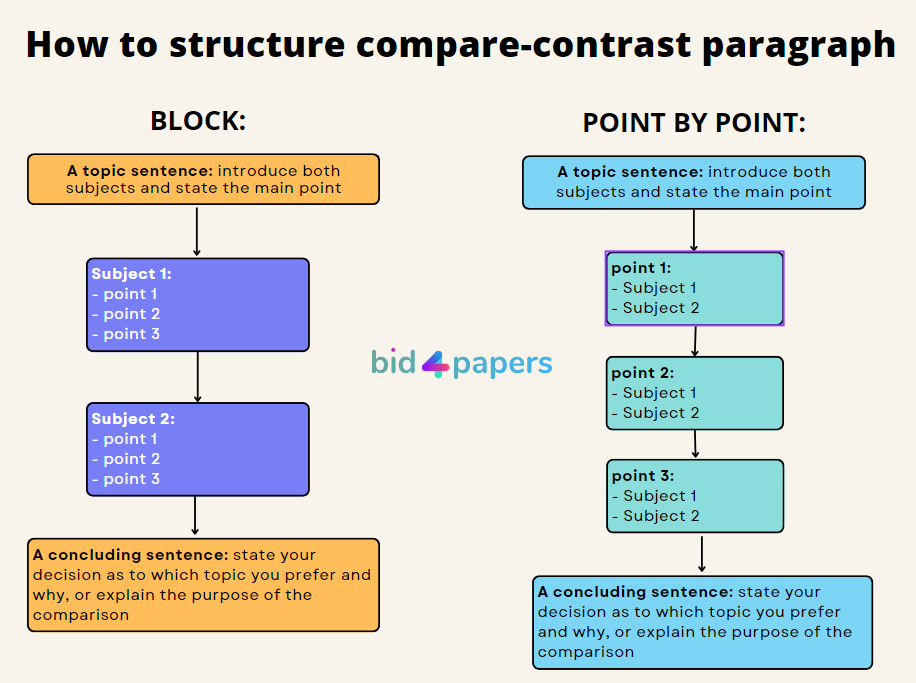
The block method is easier to write, but the point-by-point one is clearer because it demonstrates the similarities and differences more explicitly.
Let’s try structuring a compare-contrast paragraph for the topic “Academic writing vs. professional writing.”
Say you have three points/criteria to discuss each of these two subjects: paragraph structure, point-of-view, and tone. That’s what your paragraph might look if you wrote it using a block method:
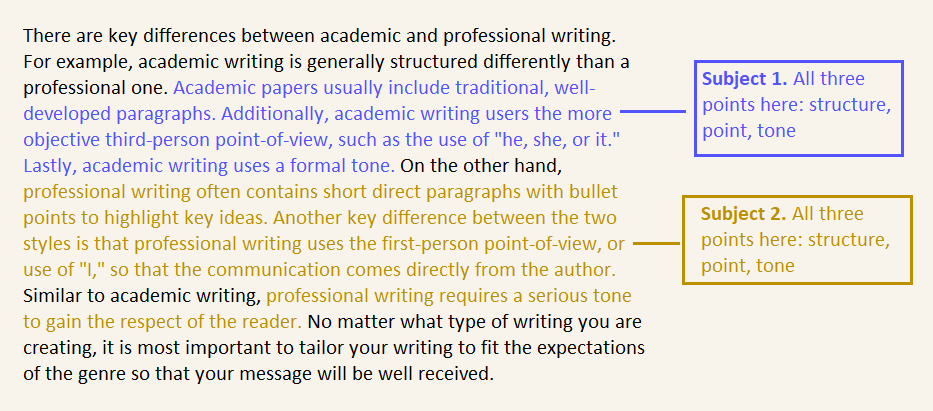
First, you discuss all three points about Subject 1 (academic writing) and then move to all three points about Subject 2 (professional writing).
And here goes the example of the same paragraph but written with a point-by-point method:
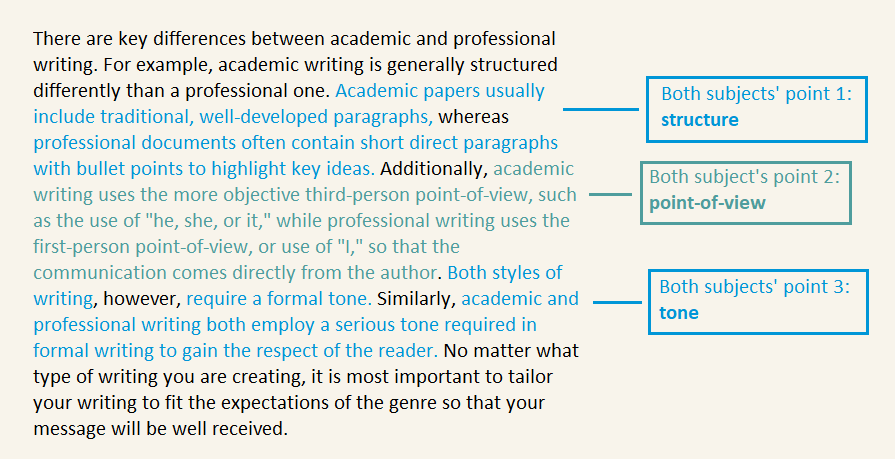
You discuss both subjects — academic writing and professional writing — simultaneously, point by point: First, you speak about their paragraph structure, then move to their point-of-view, and finally compare their tone.
Step 5: Write an Outline
Whatever method you choose to structure the paragraphs of your compare and contrast essay, it’s critical to craft its outline before writing:
An essay outline is a skeleton of your paper. It helps organize all the points so it would be easier to write and see which approach you’ll take for each paragraph, not to miss anything.
How to write a compare and contrast essay outline:
- For the introduction, state a hook, a topic, and a thesis.
- For body paragraphs, specify the similarities and differences for each point you’re going to cover about the subjects.
- For the conclusion, summarize the points, restate a thesis, and think of what decision/solution you’ll introduce to readers about the topic.
Step 6: Start a Draft
Here’s how to start it:
Write a hook to grab the reader’s attention (it can be a question, a rare fact, or a bold statement about your topic); then, introduce the subjects you’ll discuss; and finally, state your thesis at the end of the introductory paragraph.
Now it’s time to write the first body paragraph:
Start with a topic sentence that explains the point of comparison between your two subjects. Then, devote at least two sentences to the similarities and the other two — to the differences. Finish the paragraph with a concluding sentence, explaining which subject you prefer and why, or just revealing the purpose of this comparison.
Use the same principle when writing the other paragraphs. Remember the method you’ve chosen to structure them (block or point-to-point) and craft the draft accordingly. The detailed outline will help you follow the structure and organize the paper.
Writing tips:
- Back up your points with evidence: research, books, statistics, and other references.
- Ensure you use compare-contrast linking words throughout an essay. They will help you show the relationship between the ideas and connect your points.
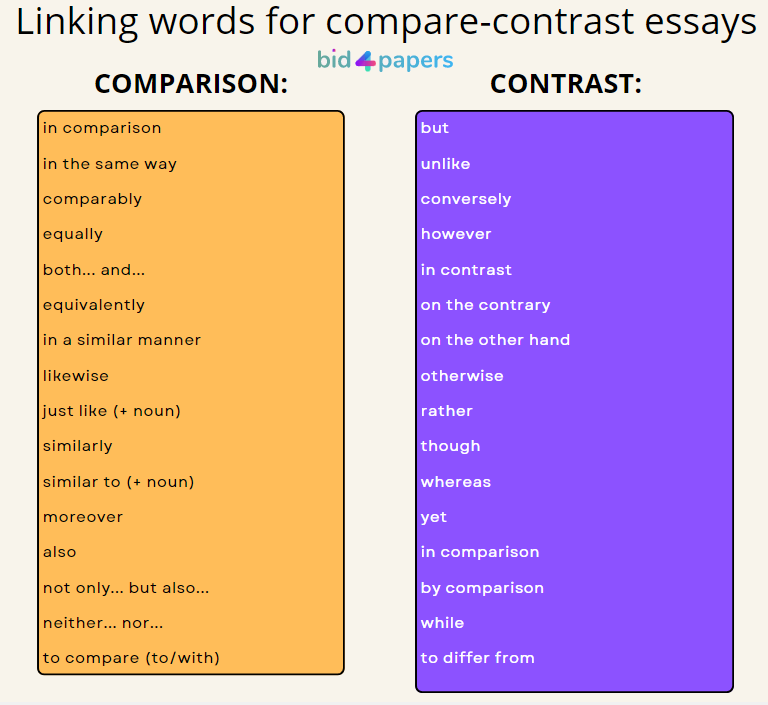
How to write a conclusion for a compare and contrast essay:
Complete your essay with a final paragraph that will prove your thesis about how two subjects relate to each other and how they are different and alike. State your decision about the subject you prefer and why.
Be persuasive: Your essay conclusion needs to summarize the whole paper and leave the reader with the impression of your opinion.
Step 7: Proofread and Edit Your Essay
The last stage of essay writing is proofreading and editing the draft: Read it several times to ensure there are no spelling, grammar, or punctuation mistakes.
Tip: Read it out loud. It will help you “hear” every typo, and thus you won’t miss anything.
Try: Read My Essay tool from Bid4Papers. You can copy and paste the draft — and listen to a voice reading your work; thus, you’ll hear the typos and the rhythm to ensure your essay sounds good.
You can also use spellcheck and grammar check tools for proofreading your essay. They are great helpers, but we wouldn’t recommend you to 100% rely on them: Tools can’t understand the style, tone, and readability of your work; they won’t see the difference between “their” and “there” or “your” and “you’re,” etc. Use writing apps, but don’t make them the only instrument to consider.
More details: How to Proofread an Essay
Or, ask a friend or family member to read your essay draft. They’ll look at it objectively and with a fresh pair of eyes, which is easier to notice bugs you might have missed.
Below you’ll find a checklist for compare and contrast essays. Feel free to use it when editing your draft to ensure you’ve covered all the details this essay type must have to become A-worthy.
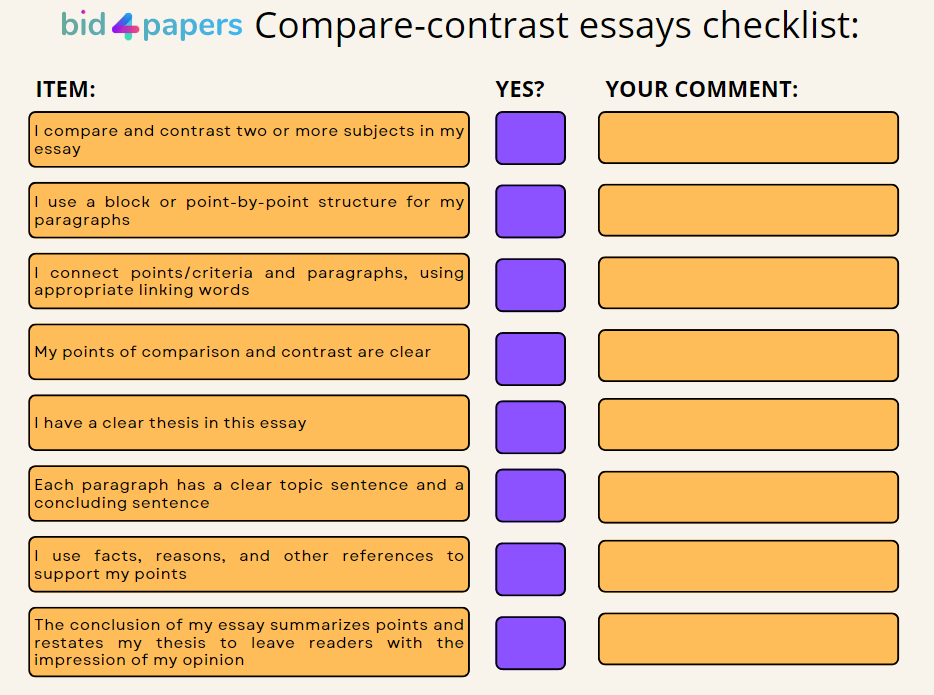
Compare and Contrast Essay Examples
Below is the compare and contrast essay about American vs. Turkish fast food, focused on the similarities:
In recent years more people are eating food outside their homes. Due to changing work and social lifestyles, many people spend more time in restaurants and cafes. There are many food choices to eat, but in this country, two of the most common are American fast food and Turkish fast food. American and Turkish fast foods are similar to each other in two main ways, they are both unhealthy, and they are both convenient. Firstly, both American and Turkish fast food can be harmful to our health. Both are high in fat, sugar, and calorie content. Because of this, they can be addictive, often leading to an increase in body weight and some cases obesity. Moreover, both American and Turkish fast foods are created in factories and are made to have a long shelf life. They both contain many preservatives and chemical additives, which have unforeseen effects on bodily health. Secondly, American and Turkish fast foods are similar in that they are convenient. To begin with, both are inexpensive. These foods, which will easily fill your stomach, can be bought for the same price as a bowl of soup. In addition, as indicated in the name, both are "fast." With busy work and social schedules, many people need to eat quickly and often whilst walking, using public transport, or driving. Therefore, not only American but also Turkish fast foods are conveniently quick and easy to eat. In summary, American and Turkish fast food are alike in that they are both damaging to health and that they are both convenient. In the 21st century, fast food is common and very popular; we must consider the negative impact of these foods on our future as individuals and as a society.
For more examples, check these resources:
- Elementary School and Middle School: The Differences and Similarities
- Large Leap
- Comparing and Contrasting London and Washington, DC
Please, don’t use any of them as your work: They are samples for you to understand the nature and structure of compare and contrast essays better.
Need Help With Essay Writing?
Now that you know how to write a compare and contrast essay, it’s time to surprise a teacher with a well-crafted paper! Choose a subject, decide on similarities and differences you’ll compare, follow the structure when writing an outline, and remember to proofread your essay once the draft is ready.
Still in doubt if you can do that like a boss?
Hire a professional writer here at Bid4Papers to help you with the assignment!
